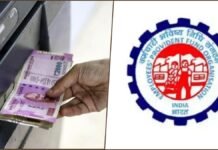
Key Points:
- MoU signed November 3, 2025 during EPFO’s 73rd Foundation Day celebration
- Covers Employees’ Pension Scheme (EPS-1995) pensioners under age 60+ requirements
- 1.65 lakh post offices and 3+ lakh postal workers to deliver service nationwide
- Digital Life Certificate (Jeevan Pramaan) uses facial recognition and fingerprint biometric
- Service completely free EPFO bears entire cost of certificate issuance
- Certificate available online within 24 hours after doorstep verification
- Particularly benefits rural and semi-urban pensioners with limited mobility
- Aligns with Digital India and Ease of Living government initiatives
- IPPB first launched this service in 2020; now expanding to millions more pensioners
- No paper submission required; eliminates annual office queue visits for 60+ seniors
New Delhi: The partnership between India Post Payments Bank and the Employees’ Provident Fund Organisation addresses a long-standing pain point for India’s senior citizen pensioners. For decades, retirees have faced the mandatory annual ritual of submitting paper-based life certificates to confirm they remain alive, a requirement designed to prevent fraudulent pension payments but that has burdened millions of elderly citizens with physical office visits, long queues, and bureaucratic friction.
IPPB MD and CEO R. Viswesvaran explained the initiative’s broader significance: “This partnership with EPFO reinforces IPPB’s mission to bring essential financial and citizen services to every doorstep in India. With our technology-enabled postal network and trusted last-mile reach, EPFO pensioners, especially in rural and semi-urban areas, will now be able to complete their life certificate submission seamlessly, with dignity and convenience.”
The Massive Reach: 1.65 Lakh Post Offices, 3 Lakh Postal Workers
India Post Payments Bank operates one of the world’s most extensive distribution networks, a critical advantage for serving dispersed senior citizens across India’s vast geography. The partnership mobilizes:
- 1.65 lakh post offices (165,000 facilities) positioned in nearly every village, town, and urban center
- 3+ lakh postal service providers, including postmen and Gramin Dak Sevak, who visit homes for mail delivery
- Doorstep banking devices equipped with biometric and facial recognition technology capable of field-based authentication
This infrastructure ensures that pensioners in remote villages, mountainous regions, and sparsely populated areas who previously faced days of travel to reach EPFO offices can now complete verification from their homes.
How the Service Works: Three Simple Steps
The doorstep digital life certificate process has been deliberately simplified to accommodate elderly citizens with limited technological comfort:
Step 1 – Initiation: Pensioners either contact their local postman/Gramin Dak Sevak directly or visit the nearest post office. No advance appointments required; no application forms necessary.
Step 2 – Biometric Verification: The postal worker verifies the pensioner’s identity using two independent authentication methods—facial recognition linked to Aadhaar and fingerprint biometric scanning. These redundant verification layers ensure accuracy while being quick and non-invasive for elderly participants.
Step 3 – Certificate Generation and Access: Upon successful authentication, the government automatically generates the Digital Life Certificate (Jeevan Pramaan). The pensioner receives an SMS confirmation on their registered mobile number, and the certificate becomes accessible online through the Jeevan Pramaan portal the next business day.
The entire process from initial contact to certificate delivery typically requires only 15-20 minutes per pensioner, compared to hours spent waiting in office queues previously.
Zero Cost to Pensioners: EPFO Bears Full Burden
A critical feature distinguishing this partnership from other doorstep services is the complete cost elimination for pensioners. The Employees’ Provident Fund Organisation contractually assumes responsibility for issuing and delivering all digital life certificates, making the service absolutely free for participating pensioners. This absence of charges removes any financial barrier to participation, particularly important for lower-income retirees subsisting on modest pension amounts.
This cost structure reflects policy recognition that senior citizens already managing fixed incomes often inadequate for rising living expenses, should not bear additional fees for mandatory government compliance procedures. By positioning EPFO as the payer rather than pensioners, the government eliminates the regressive impact of service charges on vulnerable populations.
Jeevan Pramaan: The Digital Certificate Explained
The Digital Life Certificate derives its Tamil name “Jeevan Pramaan” (meaning “Certificate of Life”), reflecting India’s multilingual governance framework. Technically, the Jeevan Pramaan functions as an electronic substitute for traditional paper certificates submitted annually to prove a pensioner remains alive and eligible for continued pension disbursement.
Government verification systems previously required paper submissions, creating administrative overhead, document loss risks, and inconvenience for pensioners. The digital format accomplishes identical verification purposes while eliminating paper handling, storage, and processing delays. Once generated, the Jeevan Pramaan certificate remains valid for the calendar year and automatically integrates with EPFO’s pension disbursement systems, removing the need for pensioners to proactively submit documentation to multiple offices.
The Scale of Impact: 2.3 Crore Pensioners
The Employees’ Pension Scheme (EPS-1995) currently covers approximately 2.3 crore (23 million) pensioners, a population approaching that of entire mid-sized nations. These beneficiaries range from former public sector employees, private sector workers with legacy pension coverage, and others covered under India’s oldest pension architecture. Bringing digital life certificate services to this massive population through the doorstep model represents one of India’s largest digital governance expansions for senior citizens.
Before this partnership, pensioners accessed digital life certificates primarily through IPPB’s existing service launched in 2020, but adoption remained incomplete given that many elderly citizens lacked awareness, internet access, or comfort with digital tools. By bringing the service to pensioners’ homes rather than requiring them to visit post offices, this partnership addresses adoption barriers and reduces digital literacy requirements.
Special Emphasis on Rural and Semi-Urban Coverage
While urban centers possess sufficient EPFO offices and banking infrastructure to serve pension verification needs, rural and semi-urban areas face chronic service delivery gaps. Senior citizens in villages and smaller towns frequently endure multi-hour journeys to reach offices capable of processing life certificates, creating unnecessary physical strain and transportation costs.
The postal network’s ubiquity in rural India directly addresses this disparity. Nearly every Indian village, regardless of population size, maintains at least one post office. Additionally, postmen’s regular home delivery routes mean that many pensioners already know their local postal worker—creating familiarity and trust that facilitates biometric verification completion.
Union Minister for Labour and Employment Mansukh Mandaviya emphasized this rural focus during the MoU signing ceremony: “This initiative particularly supports rural and semi-urban senior citizens who previously faced significant logistical barriers to completing annual verification procedures.”
Alignment with Digital India and Ease of Living Visions
The partnership strategically aligns with two central government policy frameworks:
Digital India Vision: The government’s comprehensive mission to make digital services accessible nationwide requires expanding digital infrastructure beyond urban concentrations. By leveraging postal networks and Aadhaar-linked biometric systems for pension verification, the government advances digital transformation while ensuring inclusive coverage across socioeconomic and geographic divides.
Ease of Living Initiative: Prime Minister Narendra Modi’s “Ease of Living” agenda prioritizes reducing bureaucratic friction and enhancing quality-of-life for ordinary citizens, particularly vulnerable populations. Delivering pension verification services to elderly citizens’ doorsteps directly embodies this principle—transforming an annual burden into a brief, convenient interaction at home.
IPPB’s Evolution: From Payment Banking to Civic Services
Established in 2018 under the Department of Posts, India Post Payments Bank initially focused narrowly on payment services—accounts, deposits, and financial transactions accessible through postal networks. The organization’s mandate has progressively expanded to encompass broader civic services delivery, with digital life certificates representing a pivotal example of mission evolution beyond traditional banking.
IPPB’s operational model, leveraging postal infrastructure and workers, proves particularly effective for government service delivery in contexts where population density, income levels, or digital literacy traditionally created market failures. By subsidizing services through government contracts (rather than relying on commercial viability), IPPB achieves universal coverage objectives impossible in purely commercial models.
Technology and Privacy: Aadhaar-Linked Biometric Authentication
The service utilizes Aadhaar-linked biometric authentication, India’s 1.4+ billion citizen identity system linked to fingerprint and facial biometric data. This integration provides several advantages:
Fraud Prevention: Biometric uniqueness eliminates identity spoofing, ensuring certificates genuinely confirm specific individuals’ continued existence.
Automated Verification: Aadhaar’s centralized database enables instantaneous identity validation, reducing manual verification time and error rates.
Cross-Government Integration: EPFO can automatically receive Jeevan Pramaan certificates through integrated government systems, eliminating separate submission processes.
Privacy Framework: While Aadhaar-based systems have historically triggered privacy concerns, the limited scope of biometric sharing specifically for life verification provides targeted use of identity data rather than broader surveillance integration.
Addressing Senior Citizen Challenges: Mobility, Dignity, and Access
For India’s 60+ population, currently approaching 150 million citizens, annual life certificate submission represents a meaningful logistical challenge. Elderly individuals with mobility limitations, chronic health conditions, or caregiving responsibilities face a particular burden from mandatory office visits. Some pensioners have reportedly missed pension disbursements due to missed deadlines caused by health emergencies preventing office access.
Doorstep verification directly addresses these challenges by eliminating travel requirements while preserving the dignity of home-based verification rather than office waiting room experiences. Additionally, the biometric process avoids document-heavy procedures that overwhelm seniors with limited administrative experience.
Integration with Existing IPPB Doorstep Service
IPPB’s digital life certificate doorstep service, initially launched in 2020 with limited awareness and adoption, now receives institutional support and promotion through the EPFO partnership. The mutual reinforcement benefits both organizations—IPPB expands service utilization and reaches new beneficiary populations, while EPFO achieves cost-effective verification scaling.
The 2020-2025 experience with doorstep digital certificates generated valuable operational lessons about biometric authentication in field conditions, elderly user interaction patterns, and process optimization. Incorporating these insights into the expanded EPFO deployment ensures smoother service delivery at scale.
Future Expansion Possibilities
The IPPB-EPFO partnership model potentially creates a template for additional civic service delivery. Observers suggest similar structures could extend to:
- Widow pension verification for beneficiaries of central and state widow schemes
- Disability benefit certification through periodic biometric verification
- Senior citizen welfare scheme enrollment consolidating fragmented state-level programs
- Death registration services enabling real-time notification to multiple government departments simultaneously
By demonstrating the postal network’s capacity for nationwide biometric-enabled service delivery, the EPFO partnership positions IPPB as a potential backbone for diverse government-to-citizen service models.
Institutional Significance: EPFO Leadership Evolution
EPFO, traditionally viewed as a bureaucratic pension fund administrator, increasingly functions as a social protection infrastructure organization. The digital life certificate partnership reflects this evolution from passive fund management toward proactive service delivery innovation. Under CPF Commissioner Ramesh Krishnamurthi’s leadership, EPFO has pursued multiple modernization initiatives, with this partnership representing perhaps the most visible beneficiary-facing transformation.
Implementation Timeline and Beneficiary Outreach
While the MoU signing occurred on November 3, 2025, rollout across all 1.65 lakh post offices and 3+ lakh postal workers requires phased implementation. Initial pilot operations may focus on specific regions (likely high-density pensioner areas and states with strong postal infrastructure), with national expansion over subsequent months.
Critical implementation challenges include training postal workers in biometric device operation, establishing data security protocols to prevent unauthorized access to pensioner information, and communicating service availability to dispersed elderly populations with limited digital media exposure.
The Human Element: Postmen as First-Mile Service Providers
Ultimately, the partnership’s success depends on frontline postal workers, postmen, and Gramin Dak Sevaks who maintain direct relationships with pensioners across their service territories. These workers’ familiarity, trustworthiness, and patience become critical variables determining pensioner cooperation with biometric verification processes. Initial implementation success likely depends on comprehensive worker training, performance incentives, and quality assurance mechanisms ensuring standardized service quality across diverse geographic contexts.
The initiative represents not merely technological modernization but social infrastructure transformation, meeting senior citizens where they live rather than requiring them to navigate bureaucratic systems.

















































